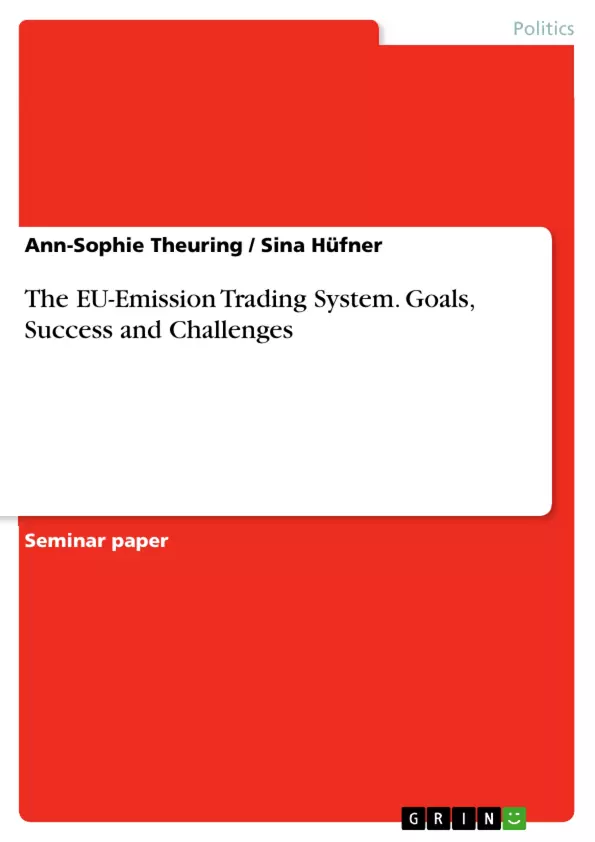This term paper discusses how to improve the European Union Emission Trading Scheme to have the lowest possible influence on companies with the highest possible reduction of greenhouse gases. Even though in theory this scheme may appear flawless there are a few conflicts and negative consequences which have a big influence on some participating countries.
To get an overview, the problem of the emissions has to be explained first. After that, it is essential to explain the theory of the European Union Emission Trading Scheme with a summary of the main expected theoretical effects. There must be an empirical evaluation about the real effects in comparison to the theoretical expected ones. This part will be followed by a discussion on how the government needs to change the scheme to improve the consequences. At last, there will be a conclusion which will sum up the outcome of the discussion and give a perspective on the future.
Being and staying healthy is one of the greatest wishes of humanity because it is assuring a longer life. But not only a highly developed health system protects people from illnesses, also living in a clean and safe environment extends the span of life. This is why it is always interesting to discuss new solutions of the government which shall protect the environment, improve our climate and increase our sustainability. In year 1997 the Kyoto protocol was added to the United Nations Framework Convention on Climate Change, short UNFCCC, to reduce those emissions gradually. In addition to this contract the European Union created in 2005 the European Union Emission Trading Scheme, short EU ETS. It allows companies to buy and trade a certain amount of emission permits.
Inhaltsverzeichnis (Table of Contents)
- Introduction
- The natural and anthropogenic greenhouse-effect
- The European Union Emission Trading Scheme
- The effects of pollution on the market
- The Emission Trading Scheme and its expected effects
- Empirical evaluation
- Consequences
- Conclusion
Zielsetzung und Themenschwerpunkte (Objectives and Key Themes)
This seminar paper explores the European Union Emission Trading Scheme (EU ETS), examining its goals, successes, and challenges. It aims to analyze the scheme's effectiveness in reducing greenhouse gas emissions and its impact on various stakeholders, including companies and participating countries.
- The negative externality of pollution and its market effects
- The EU ETS as a mechanism for reducing greenhouse gas emissions
- Empirical evaluation of the EU ETS's effectiveness and real-world impact
- Consequences of the EU ETS for participating countries and companies
- Potential improvements and future directions for the EU ETS
Zusammenfassung der Kapitel (Chapter Summaries)
- Introduction: This chapter sets the stage by discussing the importance of environmental protection and the growing concern over greenhouse gas emissions. It introduces the EU ETS as a policy response to this issue and outlines the structure of the paper.
- The natural and anthropogenic greenhouse-effect: This chapter explains the natural greenhouse effect and its role in maintaining a habitable planet. It then examines the anthropogenic greenhouse effect caused by human activities, highlighting the role of traffic, industry, and agriculture in emitting greenhouse gases.
- The European Union Emission Trading Scheme: This chapter delves into the EU ETS, exploring its theoretical framework and expected effects. It discusses the concept of pollution as a negative externality and how the EU ETS aims to incentivize emission reduction.
- Empirical evaluation: This chapter examines the real-world effectiveness of the EU ETS by analyzing empirical data and comparing it to the theoretical predictions. It assesses the scheme's successes and shortcomings in achieving its goals.
- Consequences: This chapter explores the various consequences of the EU ETS for participating countries and companies. It analyzes the economic, environmental, and social impacts of the scheme and identifies potential challenges and opportunities.
Schlüsselwörter (Keywords)
This seminar paper centers around the European Union Emission Trading Scheme (EU ETS), exploring its goals, effectiveness, and challenges. Key concepts include greenhouse gas emissions, climate change, environmental policy, market mechanisms, pollution as a negative externality, and the role of government regulation in addressing environmental issues. Empirical data and case studies are used to evaluate the EU ETS's impact on participating countries and companies.
- Quote paper
- Ann-Sophie Theuring (Author), Sina Hüfner (Author), 2016, The EU-Emission Trading System. Goals, Success and Challenges, Munich, GRIN Verlag, https://www.grin.com/document/374554



